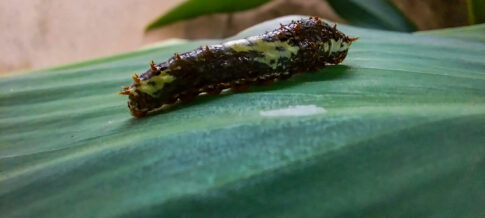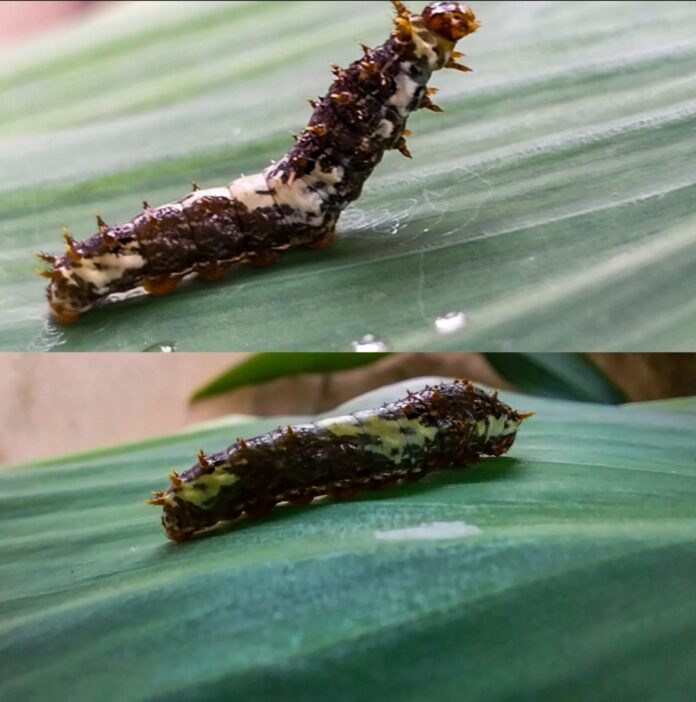Nature & Ecosystem ll Papilio aegeus Donovan: An Leaf eating Caterpillar mostly found in lemon trees. This species is presumably named after the great King Aegeus of Ancient Greece. Although this Caterpillar is a pest on Lemon trees, it is one of the most interesting Caterpillars, Both its structure and its behaviour have evolved to an extraordinary degree to give it protective mechanisms against predators. It also grows into one of the largest butterflies to grace gardens and nature.
The early instars of this Caterpillar are kite shaped, and dark brown with three white patches: one on the thorax, one above the the first pairs of prolegs, and one on abdominal segments 8 & 9. It is covered with black or white tubercles. The young Caterpillar often sits by day on the top of a leaf, and resembles a bird dropping. Later instars are green with white diagonal patches.
The last instar reaches a length of 6 centimetres, and is coloured yellowish green with narrow stripes or patches running obliquely upward and backward from the lower edge of the thorax to segments 4 & 6. These stripes vary in colour from pale brown to white, and are edged with iridescent mauve or blue.
In the lush, verdant landscapes where lemon trees thrive, an enchanting creature graces the foliage with its vibrant presence – Papilio aegeus Donovan, commonly known as the Lemon Tree Leaf-Eating Caterpillar. This splendid caterpillar belongs to the Papilionidae family and can be found predominantly in lemon trees across various regions. As a significant herbivore with distinct characteristics and interactions, the Papilio aegeus Donovan plays an essential role in the delicate balance of lemon tree ecosystems.
1. Identification and Appearance:
The Papilio aegeus Donovan caterpillar is a sight to behold with its striking appearance. It boasts a cylindrical body covered in an intricate pattern of black, green, and yellow stripes. Its head is adorned with a pair of long, fleshy horns that add to its distinctive appearance. These horns, called osmeteria, are everted when the caterpillar senses danger, releasing a pungent odor to deter predators.

2. Feeding Behavior and Dietary Habits:
As the name suggests, the Papilio aegeus Donovan caterpillar primarily subsists on the tender leaves of lemon trees (Citrus limon). Its strong, chewing mouthparts enable it to devour copious amounts of leaves, making it a formidable herbivore. While the caterpillar’s feeding activity might seem detrimental to the lemon tree’s foliage, it is a crucial aspect of the ecosystem, regulating leaf growth and contributing to nutrient cycling.
3. Life Cycle and Metamorphosis:
The life cycle of the Papilio aegeus Donovan is a remarkable journey of metamorphosis. It begins with the female butterfly laying eggs on the lemon tree’s leaves, usually on the underside for protection. Upon hatching, the caterpillar emerges and starts its feeding frenzy, going through several instars, or growth stages. Each instar is marked by the caterpillar shedding its exoskeleton to accommodate its expanding body.

4. Pupation and Emergence:
Once the caterpillar reaches its final instar, it undergoes pupation, transforming into a pupa or chrysalis. The pupa is secured to a suitable spot on the lemon tree, where it remains motionless for several weeks while undergoing metamorphosis. During this phase, the caterpillar’s body undergoes a radical transformation, developing into a magnificent adult butterfly.
5. Conservation and Ecological Significance:
The Papilio aegeus Donovan caterpillar, like many other insects, plays an indispensable role in maintaining ecological balance. While its feeding habits might cause temporary leaf damage, it contributes to the natural pruning of the lemon tree, stimulating new growth. Moreover, the caterpillar serves as a vital link in the food chain, providing sustenance for various predators, including birds, wasps, and other insects.
The Papilio aegeus Donovan, the Lemon Tree Leaf-Eating Caterpillar, represents the intricate beauty and harmonious interactions within lemon tree ecosystems. Its vibrant appearance and feeding habits add a touch of wonder to the already enchanting world of nature. By understanding and appreciating the significance of this caterpillar’s role, we can embrace the delicate balance of nature, and in doing so, contribute to the conservation of these marvelous creatures and their lemon tree habitats.
….Article and photographs covered by Aarav Shukla.
This article is prepared by using various information present on internet.

















